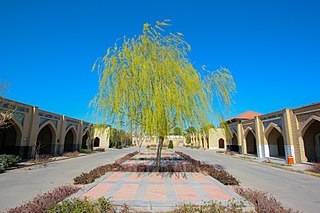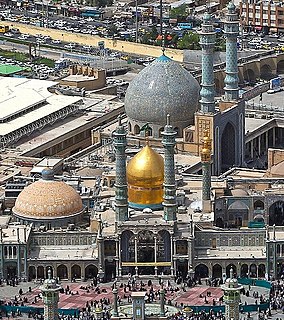Related Research Articles

Ahmad Shah Qajar was Shah of Iran from 16 July 1909 to 15 December 1925, and the last ruling member of the Qajar dynasty.

Behesht-e Zahra is the largest cemetery in Iran. Located in the southern part of metropolitan Tehran, it is connected to the city by Tehran Metro Line 1.

Dār ul-Funun, established by the Royal Vizier to Nasereddin Shah in 1851, is the oldest institute of higher learning in Iran.
In Shi'a Islam the guidance of clergy and keeping such a structure holds a great importance. The clergy structure depends on the branch of Shi'ism is being referred to.

The Shrine of Fatima Masumeh is located in Qom, which is considered by Shia Muslims to be the second most sacred city in Iran after Mashhad.

Donboli is a Turkic-speaking Kurdish tribe living around Khoy and Salmas in West Azerbaijan Province in Iran.

Ghassem Khan Vali, otherwise and better known by his military title of Sardar Homayoun, the son of Ali Khan Vali and grandson of Mohamad Ghassem Khan Vali was the first Imperial Iranian Army general to graduate from the prestigious Saint-Cyr Military School in France, which was founded by Napoléon in 1802. During the Overthrow of the Qajar dynasty, Sardar Homayoun was encouraged by the local politicians and moderates, backed by Edmund Ironside, 1st Baron Ironside and the British Government, to become the Shah of Persia. He mainly declined out of his loyalty to Ahmad Shah, although it was stated that it was out of his fear for his family's safety and his moral reluctance to use force against his countrymen, a measure which was inevitable for the maintenance of the monarchy. His reluctance was seen as cowardice by the British, and so the position was later given to Reza Shah Pahlavi.

Amanollah Khan Zia' os-Soltan was an Iranian aristocrat and politician at Qajar court during the time of Mozaffar ad-Din Shah, Mohammad Ali Shah and Ahmad Shah Qajar and hero of the Persian Constitutional Revolution.

Tabriz, Osku and Azarshahr is the biggest electoral district in the East Azerbaijan Province of Iran. This electoral district has a population of nearly 2 million and elects 6 members of parliament. In the first legislative election (1980), this electoral district had 7 MPs, but from 1984 it has had 6.

The Iranian Enlightenment, sometimes called the first generation of intellectual movements in Iran, brought new ideas into traditional Iranian society from the mid-nineteenth to the early twentieth century. During the rule of the Qajar dynasty, and especially after the defeat of Iran in its war with the Russian Empire, cultural exchanges led to the formation of new ideas among the educated class of Iran. This military defeat also encouraged the Qajar commanders to overcome Iran's backwardness. The establishment of Dar ul-Fonun, the first modern university in Iran and the arrival of foreign professors, caused the thoughts of European thinkers to enter Iran, followed by the first signs of enlightenment and intellectual movements in Iran.

The siege of Astarabad took place in June 1908 when Mohammad Baqir Khan Salar Akram was commissioned by the authoritarian government of Mohammad Ali Shah to take Astarabad from the constitutionalists. Astarabad was located in a very important strategic region because on the one hand it had access to Russia and on the other hand it was a region with the necessary strength for emergencies. Salar Akram reached the gates of Astarabad in June 1908, a week after the bombing of the parliament with his army, but Sardar Rafi Yansari, Wali of the province of Astarabad, did not allow him to enter, which led to a three-month siege; But in the end, Salar Akram was killed in a clash and the constitutionalists won. After that, a group of authoritarians revolted against Sardar Rafi, and in the end, Sardar Rafi defeated all of them.